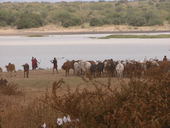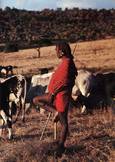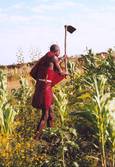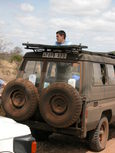Highlight
An Integrative and Interdisciplinary Approach to Conservation, Livelihoods, and Resilience around Parks and Protected Areas in East and Southern Africa
Achievement/Results
Over the past several years, IGERT faculty Paul Leslie has initiated a series of integrative, interdisciplinary research projects (funded in large part by NSF) in Kenya and Tanzania involving faculty and students at UNC-Chapel Hill. UNC’s IGERT program has both contributed to and benefited from a recent, major expansion of this collaborative work to foster a comparative perspective without sacrificing case-study detail. The broader project now entails collaboration among scientists, institutions, and communities in five countries, with participants at the University of Colorado (J.Terrence McCabe), the University of Florida (Brian Child, Michael Binford, Abe Goldman), Makerere University Biological Station (Kibale, Uganda), the Institute for Resource Assessment and the Department of Zoology and Wildlife Management at the University of Dar es Salaam (Tanzania), Namushasha Lodge (Caprivi, Namibia), the Botswana Wildlife Authority, and the Uganda Wildlife Authority. These partnerships are fostering integrative and interdisciplinary activities in and around parks and other protected areas through exciting new programs in research, education, and outreach that link across the social, natural, and spatial sciences and engage scientists and managers from each institution. This work assesses the success of protected areas in terms of both environmental and social metrics based on geospatial analysis (e.g., remotely-sensed landcover analysis), biodiversity surveys, structured and open-ended interviews, ethnographic observation, and longitudinal tracking of family economic and demographic histories.
It is commonly recognized that ecological and social systems are interlinked. Most studies in resilience literature have looked at the anthropogenic disturbances to environmental processes rather than examining how humans themselves respond to changes in social-ecological systems (SESs) and whether those changes promote or reduce resilience. Nowhere is better understanding of such responses more important than in the context of conservation of wildlife and biodiversity.
Parks and protected areas have stimulated significant social, economic and environmental change in much of Africa. Land use around parks and protected areas is changing rapidly in both East and Southern Africa, but the nature of change varies widely, with different mixes of positive and negative impacts on biodiversity and the viability of the parks on the one hand, and human well-being on the other. The reasons for these differences are poorly understood. The recently expanded project (funded by an NSF-HSD grant) permits a comparative study at five sites in eastern and southern Africa that contrast in informative ways with regard to environment, livelihood practices, interactions with wildlife, distribution of costs and benefits accruing to the park, security of land tenure, and conservation and park management policy.
This project is clarifying the impacts of parks and the processes by which parks affect the social-ecological systems (people, social institutions, wildlife, and land cover) around them, as well as the conditions that lead to divergent outcomes for ecosystem integrity and human well-being. Of special interest is how the challenges and opportunities associated with proximity to parks lead to changes in land use and livelihood strategies, and how these are mediated by perceptions of risk and opportunity at the individual level, decisions at the community level, and policies and practices at the institutional level (both government and non-government). The work is showing how parks can have direct social, economic and environmental consequences in areas neighboring a park, and that these effects in turn influence livelihoods and landscapes over a wider region, expanding the ultimate impact of the park on social-ecological systems. This work will contribute to development of participatory approaches to ecosystem management and their integration with efforts to understand SESs as complex adaptive systems (cf. Berkes 2004).
This research also stands to contribute to a currently underdeveloped aspect of our understanding of SES resilience: the consequences of diversity of responses to environmental and sociopolitical change. Such response diversity can occur at multiple levels, and research results from the past year the processes at different levels can interact in interesting and surprising ways. Work during the 2009 summer field season will focus on the determinants of response diversity (among communities and among households within communities) to new constraints and opportunities presented by the presence of parks, and on the condition under which actions taken by individuals and by village governments influence each other and may even have opposing effects on components of the SES. Insights gained from the fieldwork will inform development of agent-based models relevant to analysis of livelihood decisions and land use in the study region. preliminary agent-based modeling.
Address Goals
From a research perspective: Protected areas are the primary method of global biodiversity protection, but their establishment, maintenance, and expansion can hinder established livelihoods of local people. The literature on this conflict is large, growing, and contentious. Individual studies seldom examine underlying factors that influence protected areas from both conservation and human consequences perspectives. Understanding the role of human behavior and agency is fundamental to understanding environmental change generally, and to solving the pressing problem of simultaneously promoting both conservation and human well-being. This research is clarifying the dynamic processes by which parks act as agents of social and ecological change, and thus looks beyond just the outcomes of park-induced changes. In doing so, it contributes more generally to the empirical literature on resilience theory, and particularly to the insufficiently appreciated role of human perceptions, decision-making, and agency in enhancing or compromising the resilience of social-ecological systems. Such research clearly demands integration of perspectives from the social and natural sciences. The research results will have a direct bearing on conservation and development in Africa and perhaps elsewhere. It should suggest ways of ameliorating or avoiding many of the negative impacts of parks on human well-being and of enhancing the positive impacts.
From a discovery perspective: Increasingly, research on complex environmental and social problems demands interdisciplinary approaches, but these must be learned from experience since they are not typically part of traditional scientific training. The collaborative experience and education promoted by IGERT and this research is developing the ability of local and national African institutions to address complex issues that have a direct bearing on conservation and human well-being, at the same time as it provides experience for the IGERT trainees and sets the stage for their future collaboration with these African individuals and institutions.
Further, and more specifically, the research design and collaborative experience promotes a changing philosophy relevant to conservation and development. The negative views held by wildlife conservation scientists concerning agriculture and other livelihood activities of local peoples, and the negative views by social scientists of the burdens imposed by parks on those same people, have made joint communication and research difficult. This project’s approach fosters more integrated research and management efforts at conservation and development, and encourages constructive, informed dialog in place of polemic.
From an education perspective: The developments during the reporting period contribute toward meeting this strategic goal. The training experiences provided by this long-term interdisciplinary study of human interactions with parks and protected areas is creating a new cadre of interdisciplinary scientists (both American and African) capable of transformative and globally relevant research. One IGERT trainee (T. Baird) has already participated in two field seasons in Tanzania and will return at the end of the year to begin his doctoral dissertation research (with grant support from an NSF DDRI grant as well as from Fulbright-Hays). Another IGERT trainee, B. Miller, will receive field training and research experience this summer, and a third (S. Caplow) will do the same next year. All three of these trainees have been conducting research practica under Leslie’s guidance that contribute to the larger interdisciplinary project.
From an outreach perspective: Tim Baird incorporated his experience and perspective gained from participating in this project into a new course on “Environmental Conservation. The Connected Lives of Cheetahs, Clouds, Corn, and Communities” (GEOG 112), which he is now offered at the undergraduate level at UNC-CH.











